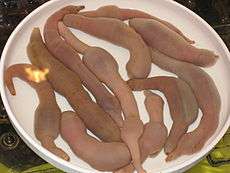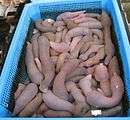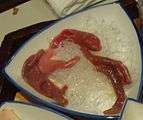Urechis unicinctus
Urechis unicinctus, known as the fat innkeeper worm or Chinese penis fish,[2][3] is a species of marine spoon worm in East Asia. It is found in Bohai Gulf of China and off the Korean and Japanese coasts.[3] It is not to be confused with a closely related species, Urechis caupo, which occurs on the western coast of North America and shares common names.[4] The body is about 10–30 cm long, cylindrical in shape and yellowish-brown in color. On the surface of the body there are many small papillae.
| Urechis unicinctus | |
|---|---|
 | |
| Urechis unicinctus at a market in Korea. | |
| Scientific classification | |
| Kingdom: | |
| Phylum: | |
| Class: | |
| Subclass: | |
| Family: | |
| Genus: | |
| Species: | U. unicinctus |
| Binomial name | |
| Urechis unicinctus von Drasche, 1881[1] | |
Ecology
This spoonworm is a detritivore, feeding on detritus, and like other species of Urechis, lives and burrows in sand and mud. It creates a U-shaped burrow in the soft sediment of the seabed. A ring of glands at the front of the proboscis secrete mucus which sticks to the burrow wall. The worm continues to exude mucus as it moves backwards in the burrow thus creating a mucus net. The worm draws water through its burrow by peristaltic contractions of its body and food particles adhere to the net. When enough food is gathered, the worm moves forward in its burrow and swallows the net and entangled food. This process is repeated, and in an area with plenty of detritus, may be completed in only a few minutes.[5][6]
Uses
In Korea, they are eaten as food, often raw with salt and sesame oil or gochujang. They are distributed in Korea, Japan, and the Pacific coast.
In Chinese cuisine, the worm is stir-fried with vegetables, or dried and powdered to be used as an umami enhancer.
It is also used as fishing bait for fish such as flounder and sea bream.
- Urechis unicinctus
 Urechis unicinctus (개불; gaebul) sold at a fish market at Busan, South Korea.
Urechis unicinctus (개불; gaebul) sold at a fish market at Busan, South Korea. Urechis unicinctus served as hoe in a restaurant in South Korea.
Urechis unicinctus served as hoe in a restaurant in South Korea.
Notes
- van der Land, Jacob; Murina, Galina Vansetti (2012). "Urechis unicinctus (von Drasche, 1881)". WoRMS. World Register of Marine Species. Retrieved 2012-11-12.CS1 maint: multiple names: authors list (link)
- "UFE - Fibrinolytic enzyme - Urechis unicinctus (Fat innkeeper worm) - UFE gene & protein". www.uniprot.org. Retrieved 2019-12-16.
- Gong, J.; Zhao, R.; Deng, J.; Zhao, Y.; Zuo, J.; Huang, L.; Jing, M. (2018). "Genetic diversity and population structure of penis fish (Urechis unicinctus) based on mitochondrial and nuclear gene markers". Mitochondrial Dna. Part A, DNA Mapping, Sequencing, and Analysis. 29 (8): 1261–1268. doi:10.1080/24701394.2018.1444039. PMID 29482423.
- Cowles, Dave (2010). "Urechis caupo Fisher and MacGinitie, 1928". Invertebrates of the Salish Sea. Rosario Beach Marine Laboratory (a campus of Walla Walla University, Washington). Retrieved 25 January 2019.
- Walls, Jerry G. (1982). Encyclopedia of Marine Invertebrates. TFH Publications. pp. 262–267. ISBN 0-86622-141-7.
- "Fat innkeeper worm". Retrieved 2019-12-15.